Capirotada (Mexican Bread Pudding)
Sweet, warmly spiced, and deliciously cheesy, my family’s Capirotada recipe is easily one of my favorite things to eat. (In fact, I love it so much that it was in my very first Muy Bueno cookbook!) This simple, 7-ingredient Mexican bread pudding is especially popular during Lent and Christmas.
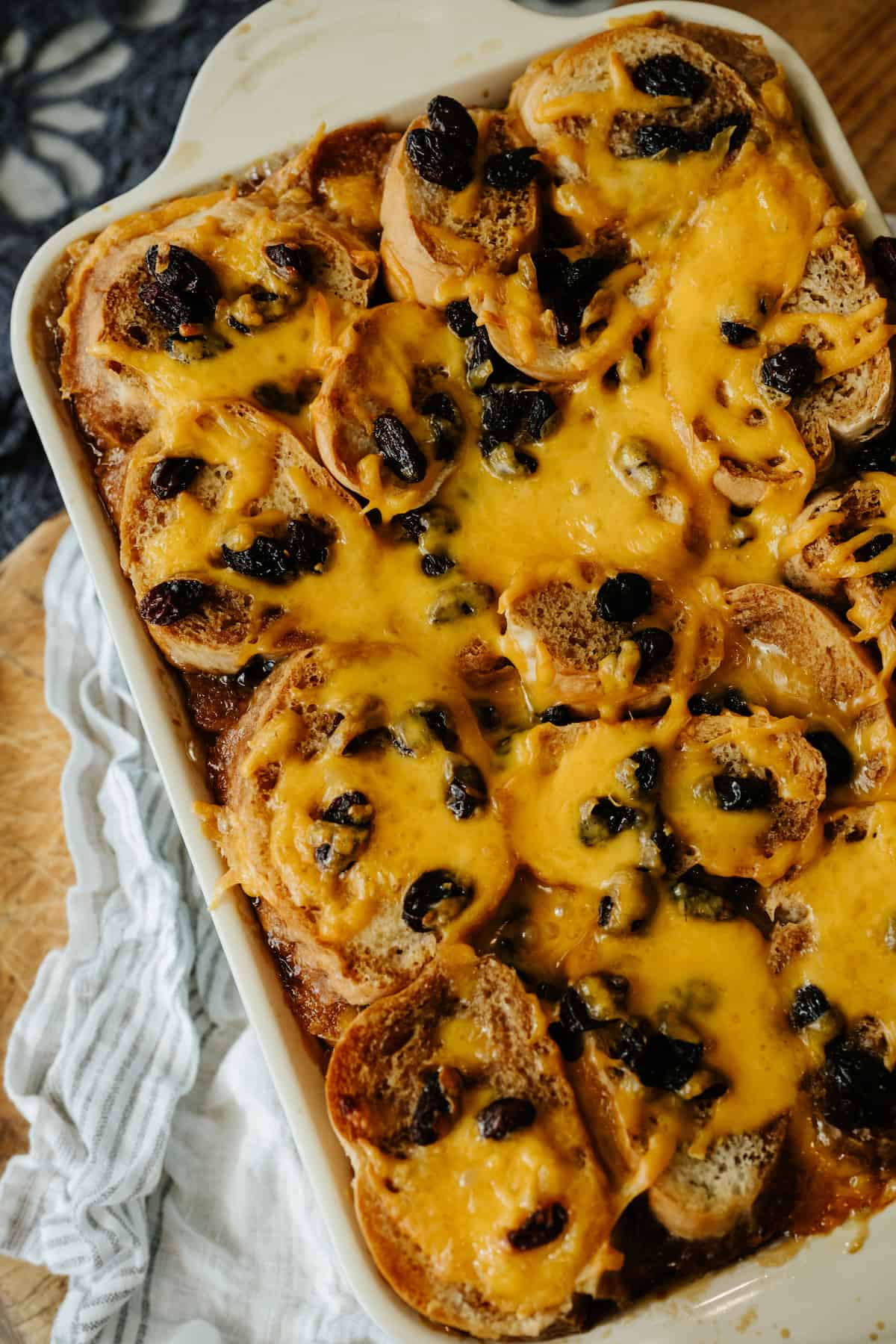
What is Capirotada?
Capirotada is a Mexican bread pudding made with cinnamon, piloncillo, cloves, raisins, butter-toasted bread, and melted cheese. Yes, you read that right…cheese in your sweet bread pudding. Don’t knock it till you try it! Have you ever tasted apple pie with a slice of cheddar cheese? This is sort of like that. It’s all about the contrast of sweet and salty.
Mexican capirotada has been around since the 1400’s, so it has some serious staying power. And as with most authentic Mexican foods, and especially with a dish as historied as capirotada mexicana, there are thousands of family recipes, each unique.
Among the many different capirotada recipes and variations I’ve seen and tried — some include milk (capirotada de leche) or sweetened condensed milk (capirotada con lechera).
Others include peanuts or almonds, bananas, coconut, and even sprinkles. My family’s recipe does not include any of that. It’s a simple capirotada de piloncillo.
As a kid, I remember working in our family’s neighborhood store (Soza’s Grocery), where friends and neighbors would bring me samples of their unique delicious Mexican dessert recipes. I’d politely try their capirotada recipes as they stood there waiting for my reaction. It was…awkward.
I couldn’t possibly tell them I didn’t like their version. Besides that, my mother would have killed me if I uttered an unkind word to one of our neighbors or customers! Instead I just stood there and thanked them.
My opinion hasn’t changed much since back then. I love our simple family capirotada recipe because it is comforting and nostalgic. That said, feel free to experiment with the add-ins you and your family like, using this recipe as your springboard.
Why is Capirotada Eaten During Lent?
Each year, Ash Wednesday marks the beginning of Lent. Lent is the solemn, 40-day (excluding Sundays) season that precedes Easter. On Ash Wednesday and all Fridays throughout Lent, many Catholics and Mexican families fast and abstain from eating meat.
The most popular food we eat during Lent is capirotada, which is steeped in religious symbolism. Many Mexican and Mexican-American families view this dish as a reminder of the suffering of Christ on the cross. The ingredients in this recipe carry a rich and symbolic representation.
Classic capirotada ingredients are associated with Jesus on the cross. The bread is for the Body of Christ, the piloncillo syrup is his blood, the cloves represent the nails on the cross, the cinnamon sticks symbolize the wooden cross, and the melted cheese is a representation of the Holy Shroud.
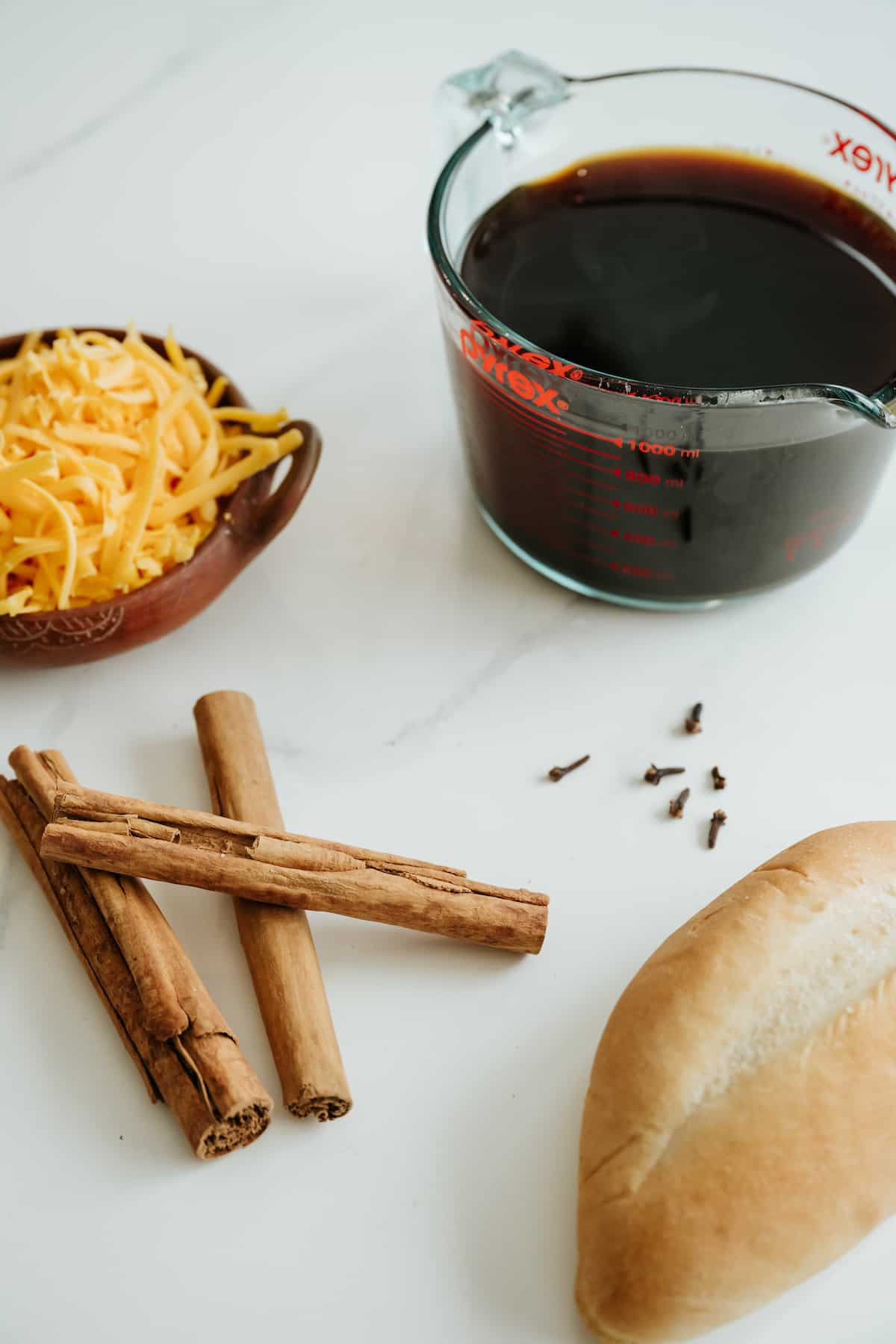
If you’re searching for a fun twist on the classic dessert, my tres leches capirotada recipe and many more recipe ideas to enjoy during Lent are in my latest cookbook, Fiestas, which is a fantastic cookbook for all our beloved holidays.
Why You’ll Love This Recipe For Capirotada
- It’s a deliciously economical dessert, and is an excellent way to use up stale bread!
- For many Mexican families, this bread pudding is incredibly nostalgic — it’s a wonderful reminder of our roots.
- It’s made with just 7 (!!!) simple ingredients, most of which are pantry staples.
Ingredients & Substitutions
The complete list of ingredients, quantities, and instructions can be found in the printable recipe card below.
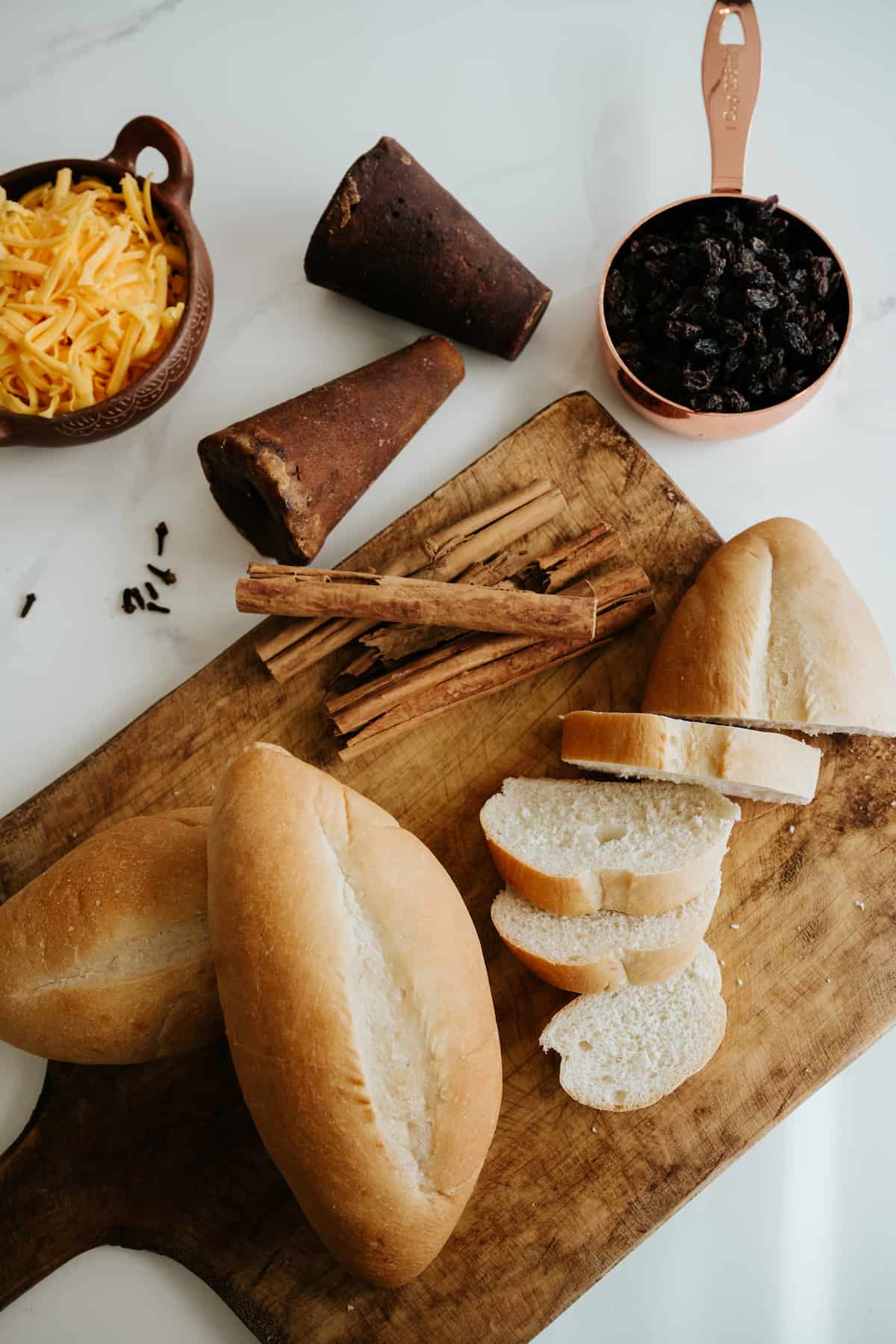
- Bolillo Rolls: These classic Mexican rolls are easily found at Latin supermarkets or panaderias (bakeries) and are used to make these veggie tortas and molletes mexicanos, both of which are perfect for Lent! You are welcome to use any other lightly crusty bread like French bread.
- Water: For making the cinnamon-clove simple syrup.
- Piloncillo: This traditional, minimally refined cane sugar adds a certain caramelly deliciousness. It’s commonly found in Mexican grocery stores, but if you can’t find it, here’s where you can buy it online. In a pinch, packed dark brown sugar is a good substitute.
- Cinnamon Sticks: If possible, try to find Mexican cinnamon (a.k.a. canela). The flavor is much milder or less spicy than the more ubiquitous Ceylon/cassia cinnamon, and there are lovely floral undertones. If not, “true” cinnamon will do the job.
- Whole Cloves: Cloves have a lovely warmth. Note that we’re talking about cloves the spice, not garlic cloves!
- Shredded Cheese: I like the contrast of flavors of salty Longhorn cheddar or Colby with the sweetness of the capirotada. If you like a mild cheese, use queso Oaxaca, queso fresco, or shredded Monterey jack cheese. It comes down to personal preference and what you love, and what you are used to.
- Raisins: Raisins are an integral part of my childhood memory of what capiratada tastes like, but you’re welcome to use the dried fruits of your choice.
- Butter: Buttering the bread before toasting adds a lovely richness. You can use butter spray for a lighter version.
How to Make Capirotada the Muy Bueno Way
Step 1: Dry Out Bread. Cut rolls in ½ inch thick slices and butter both sides, layer on a baking sheet and bake for 3 minutes on each side, until lightly toasted and dry.
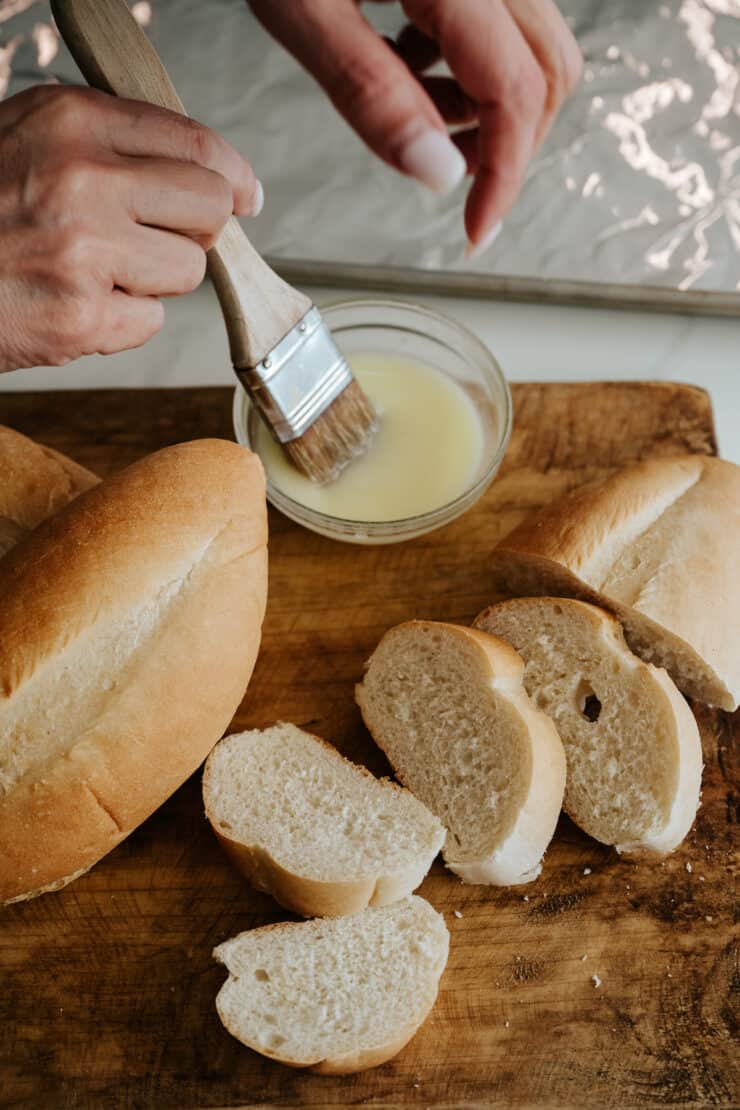
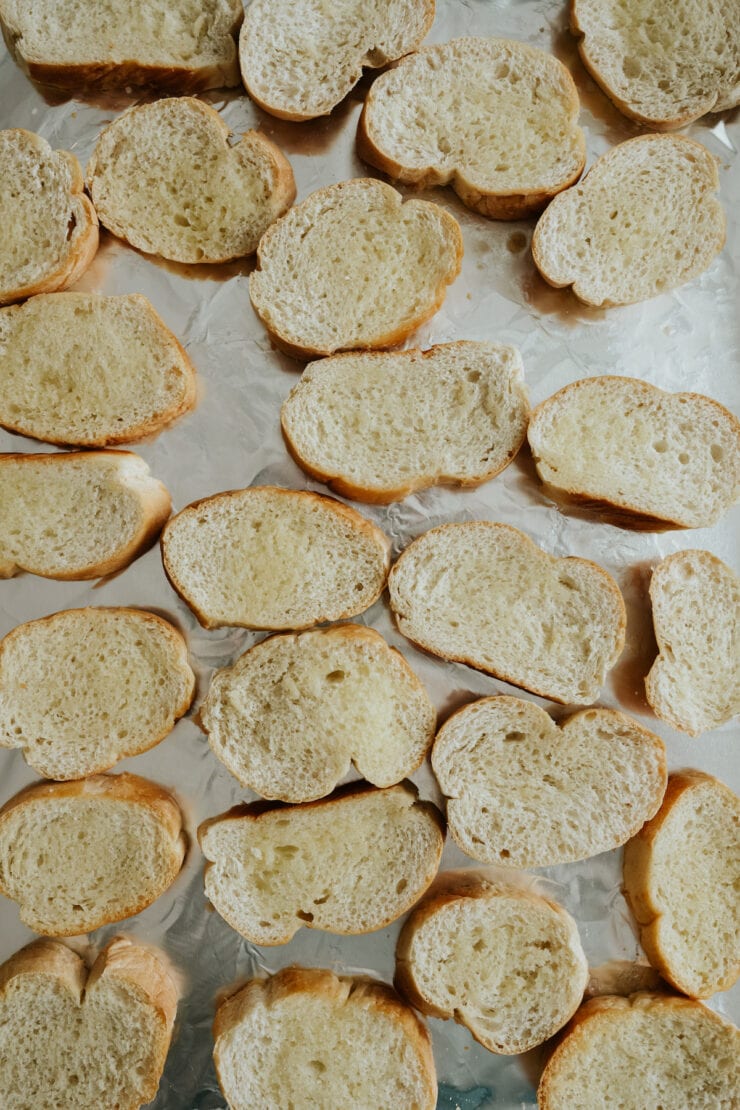
Step 2: Make Piloncillo Syrup. Combine water, piloncillo, cinnamon sticks, and cloves in a large saucepan. Bring to a boil; reduce heat, creating a thin syrup. Simmer syrup uncovered for 20 minutes. Remove from heat and let steep, covered for 2 hours. Pour through a strainer and discard cinnamon sticks and cloves. Set syrup aside.
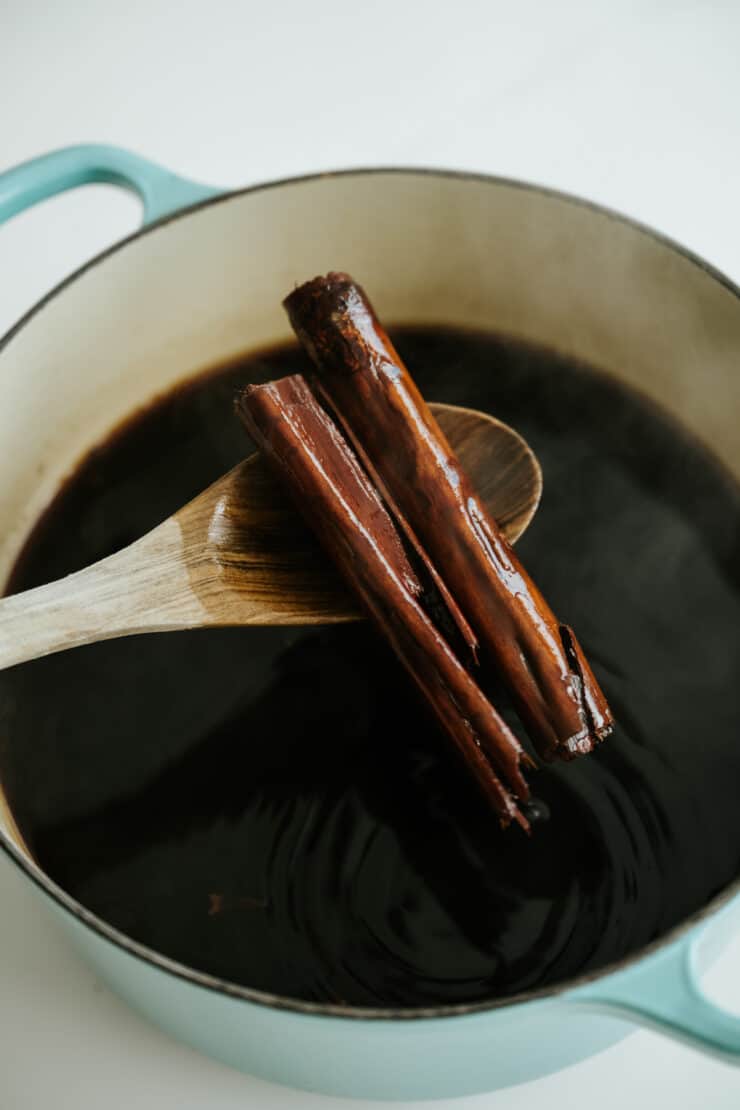
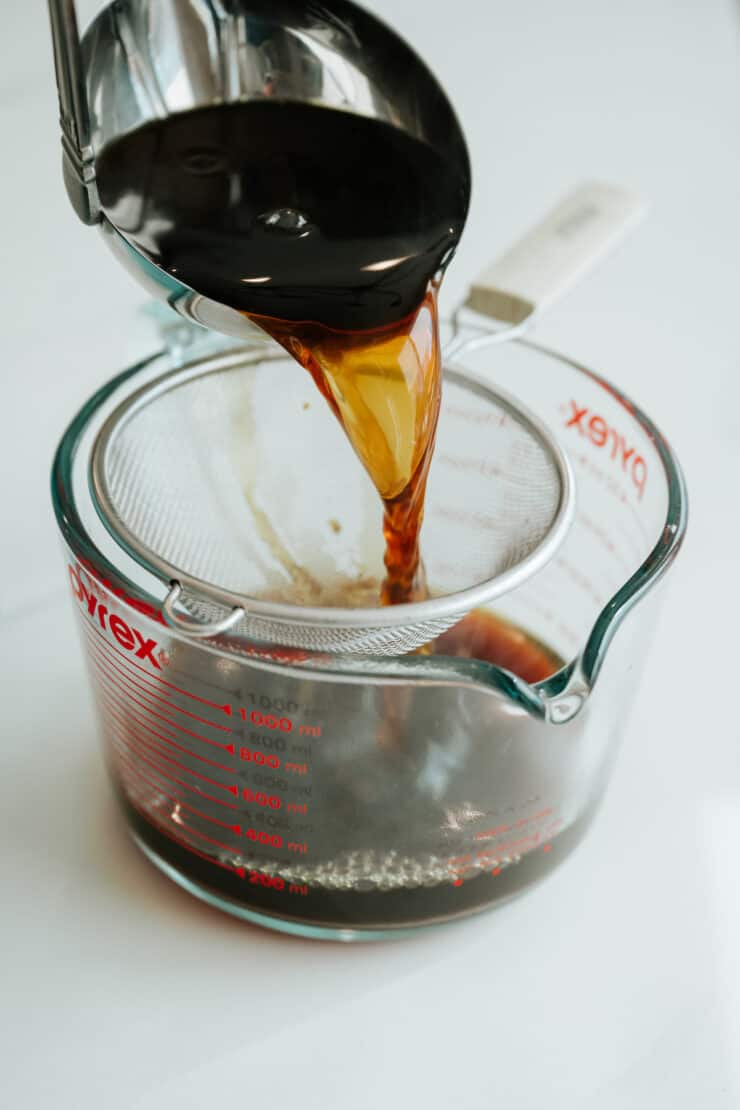
Step 3: Assemble. Spray baking dish with non-stick spray, layer ingredients in the following order: a third of the toasted bread, third of the raisins, third of the cheese, and 1 1/2 cups syrup evenly over cheese.
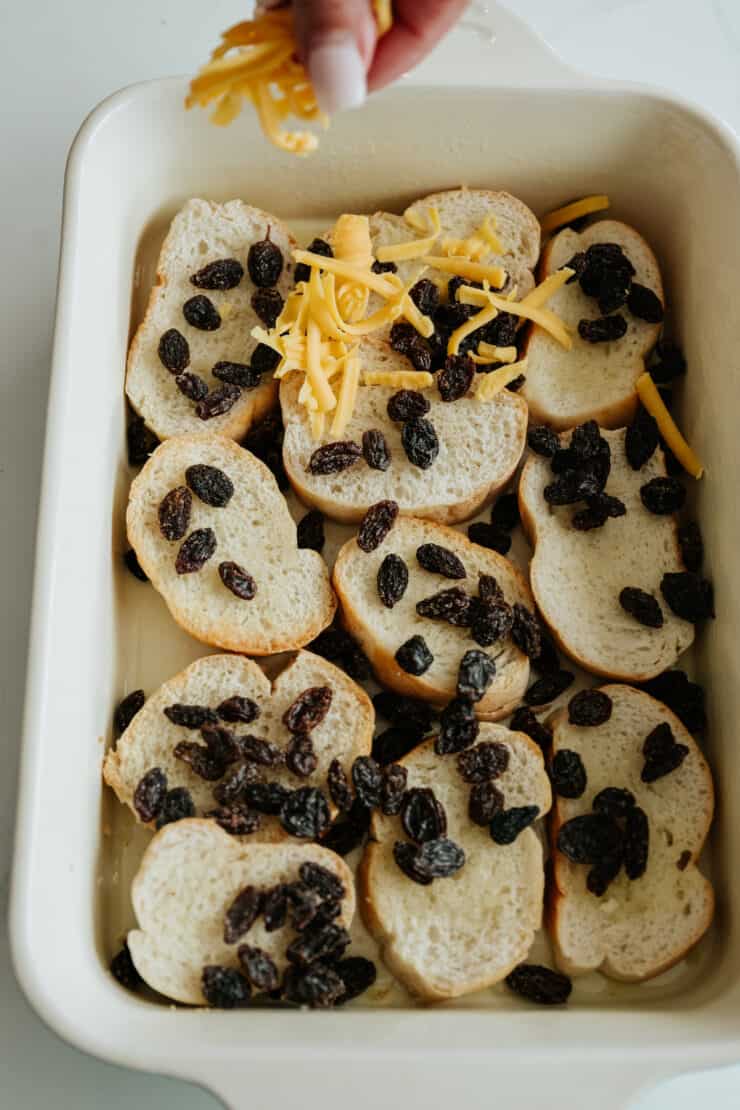
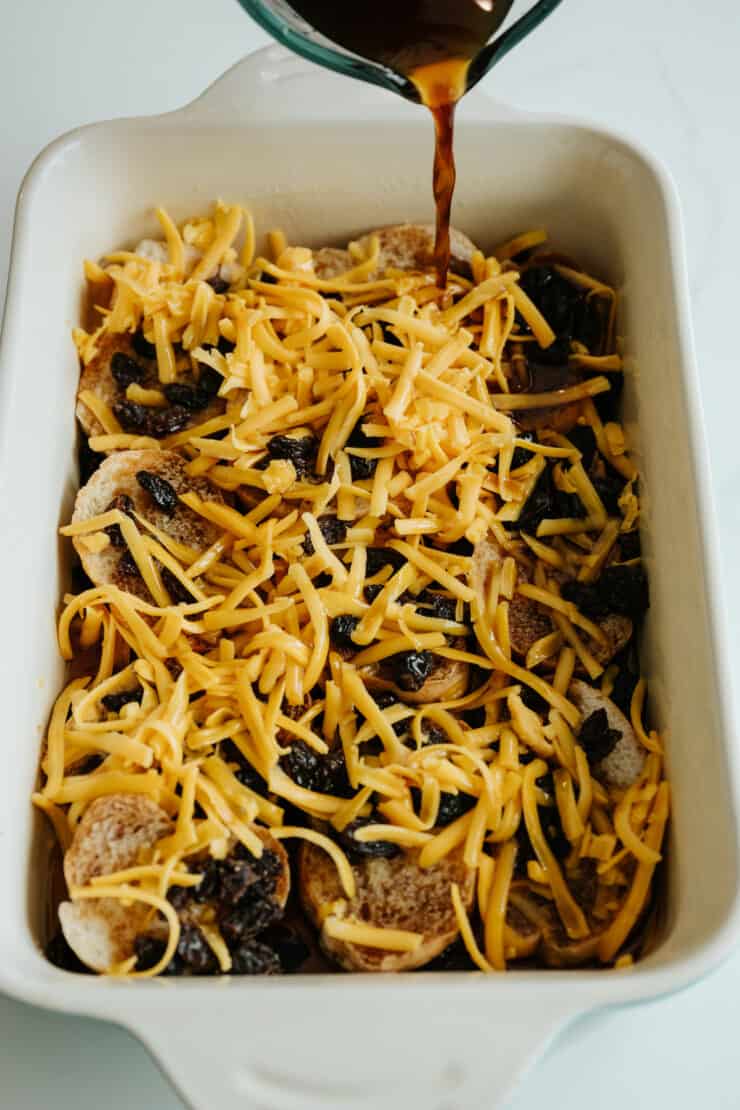
Wait 15 minutes and layer another third of the bread, raisins, cheese, and 1 1/2 cups syrup evenly over cheese. Let soak for another 15 minutes, and again top with the remaining bread, raisins, cheese, and syrup evenly over bread. Before baking let set for another 15 minutes.
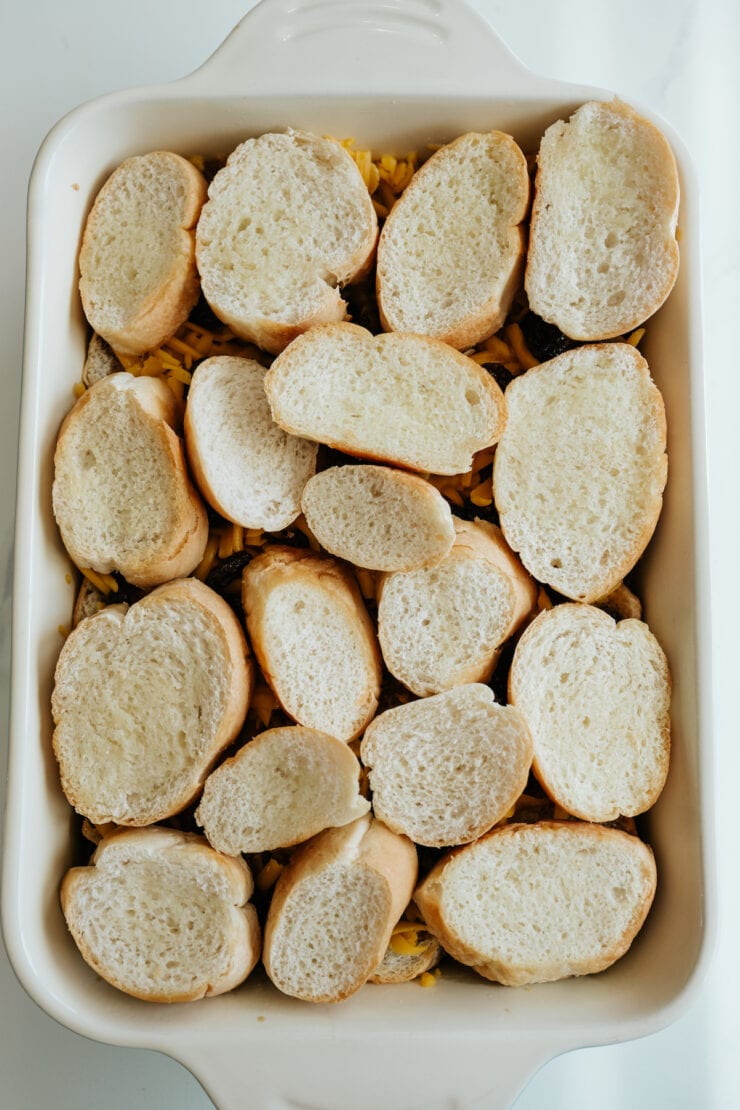
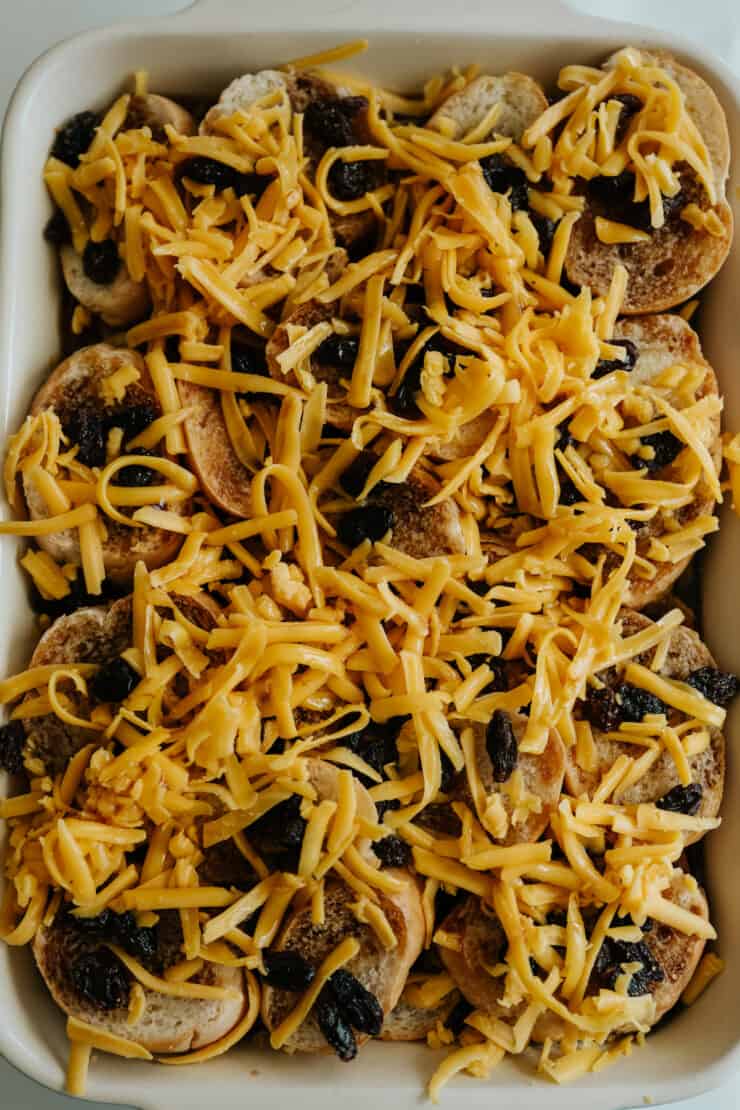
Step 4: Bake. Cover the dish with aluminum foil that has been sprayed with nonstick spray and bake 40 minutes, uncover and bake until cheese is golden brown about 10 to 15 minutes more. Serve warm.
Watch the instructional video for our heavenly capirotada family recipe. Try very hard not to eat the entire dish of capirotada at one sitting. ¡Sabroso!
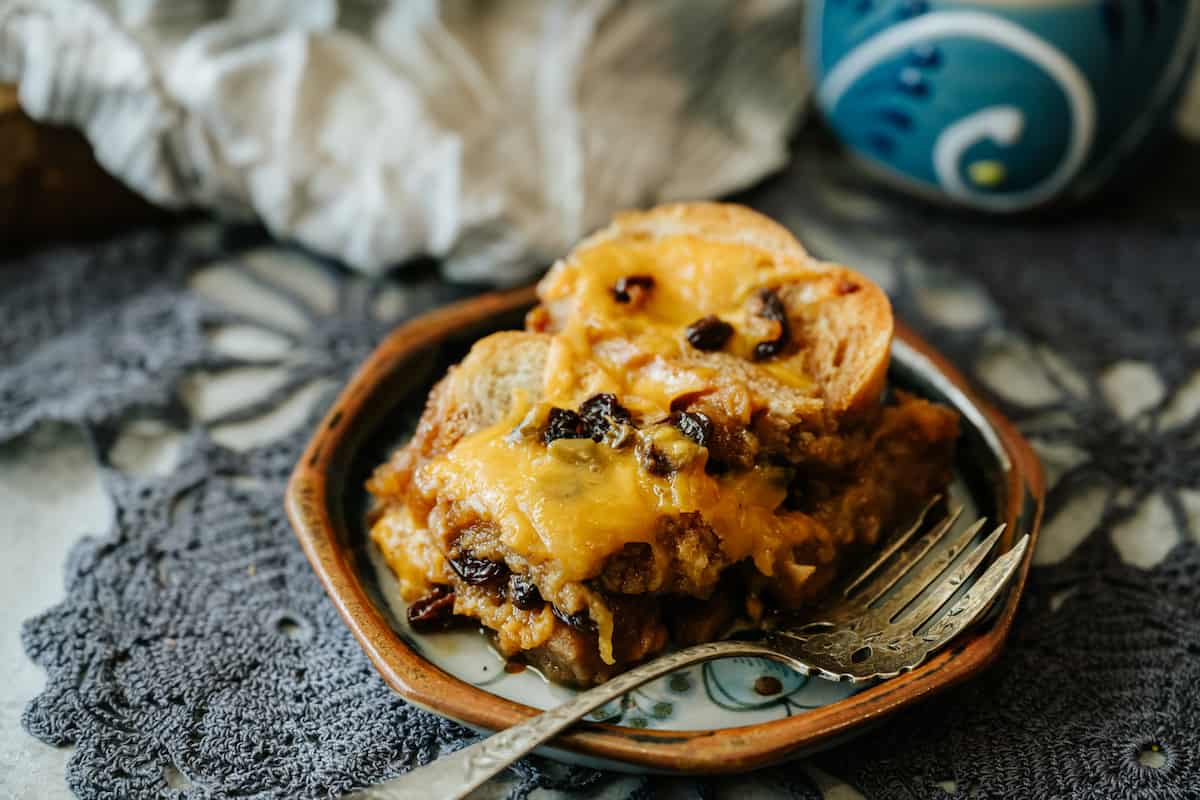
Serving Suggestions
For brunch, nothing beats the savory satisfaction of red or green chilaquiles, perfectly complemented by a side of bread pudding for dessert, accompanied by a steaming cup of café de olla.
Having a slice after lunch? I won’t tell. Make sure to pack some of my tuna patties with citrusy avocado mango salsa or a sandwich made with my mom’s best tuna salad. For dinner, try my veracruz fish soup or espuageti verde for a meal the whole family will love.

Topping Options
- Sprinkles: It might sound a little unusual, but it adds a delightful pop of color and a satisfying crunch.
- Fruits: Feel free to add the fruits of your choice, such as banana, prunes, mangos, coconut, and tomato.
- Nuts: Add almonds, peanuts, pecans, or pepitas to give the bread pudding a nutty crunch.
Expert Tips & Tricks
- Don’t rush the step-by-step soak. If you’re familiar with tres leches cake or other bread pudding or bread-based casserole recipes, you know the key to getting that custardy, soft texture is letting the dried bread soak up all the flavorful goodness!
- Don’t over-bake your Mexican bread pudding or the bread will be dry. Unlike a French-style bread pudding made with an egg custard base, this capirotada is made with fat-free, water-based simple syrup, so you don’t have as much of a window of error.
- Let the pudding cool slightly before serving. Warm capirotada? DELICIOUS! Straight-out-of-the-oven-scalding-hot-capirotada? With the melty cheese in there, it’s basically the culinary equivalent of napalm. Unless you want the whole roof of your mouth to slough off, give it 10 minutes of patience.
- Capirotada can be served warm, room temperature, or cold. I personally prefer warm, but do what calls to you!
- If your baking dish is too shallow, place a parchment-lined baking sheet underneath it to catch any potential drips.
Storage & Heating Instructions
- Feel free to prepare your capirotada up to a day ahead without baking it. It will keep in a well-covered container in the fridge for 24 hours.
- Once baked, capirotadas should be allowed to cool to room temperature before transferring it to an airtight container or freezer-friendly container. It should keep well in the fridge for up to 5 days.
- Leftovers can also be frozen for up to 3 months.
- To reheat and serve capirotada, you can gently warm refrigerated or thawed capirotada, covered, in the oven at 350 degrees F for 10 minutes. Alternatively, you can use the microwave.

Frequently Asked Questions
Both my mom and grandma used the most simple ingredients to make this old world and traditional dish, so that’s the way I’ve written the recipe below — with no coconut. As humans, we are such creatures of habit, and any capirotada that doesn’t taste like our simple family recipe just doesn’t do it for me. This basic, coconut-free version is sometimes referred to as capirotada michoacana.
It sure is! Well, at least this particular kind is. Another, more savory version of capirotada was popular in Spain in the 1300’s. The Spanish bread pudding by the same name was more what I’d consider a strata — a savory breakfast-y bread pudding featuring eggs, broth, cheese, garlic, herbs, and meat, particularly chicken and other poultry.
The conquistadors brought this recipe with them (along with Catholicism) to Latin America, and the old world methods collided with new traditions and ingredients. For example, the Aztecs had a dish that used anise tea to soak stale bread — so using a piloncillo and cinnamon-clove syrup replaced the savory broth used by the Spanish. And then, as the recipe spread, more and more families began to put their own unique Mexican spin on it.
At its most basic, Mexican capirotada is a sweet bread pudding that features crusty bread, warming cinnamon and cloves, and shredded cheese. Our family also uses raisins, but some recipes call for different dried fruit, nuts, or other inclusions like chocolate or sprinkles.
While this recipe for capirotada usually only comes out for Lent in our house, it’s also a delicious and celebratory Mexican dessert that is very popular during the Christmas holiday, but can be eaten all year round!
I personally think capirotada is best served warm (but I think that’s true of ALL bread puddings), but it’s also quite tasty at room temp.
While the word is now synonymous with Mexican bread pudding, its etymology has religious roots. Capirotada comes from the Spanish word “capirote,” which refers to the tall pointy hats worn during some Catholic ceremonies.
It sounds like “cah-PEE-row-TA-da.”
Nope, your family just uses a different name than mine does. In our house, migas are a savory breakfast dish. But many of my readers have told me they grew up calling capirotada-style bread pudding “migas,” which roughly translates to “crumbs or leftovers.” Since we make capirotada with stale or leftover bread, who am I to say you’re wrong??
Much like other global dessert traditions, there are quite a few different types of Mexican pudding. There’s rice-based arroz con leche (and, while you’re at it, my horchata rice pudding and pumpkin rice pudding) and this bread-based pudding (which I also make in adorable mini capirotada muffin form). I’d also argue that flan recipes (like my Mexican coffee flan, tres leches pumpkin flan and magic chocoflan cake) would be under the umbrella of “Mexican puddings.”
Enjoying This Capirotada (Mexican Bread Pudding)? Try These, Too:
- Capirotada (Bread Pudding) Muffins
- Mexican Style Baked French Toast Casserole
- Bourbon Bread Pudding with Harvest Berry Sauce
- Cinnamon Horchata Rice Pudding
- Mexican Pumpkin Rice Pudding
- Arroz con Leche (Mexican Rice Pudding)
- Mexican Chocolate and Avocado Pudding
If you have tried this capirotada recipe, please leave me with a star rating and comment below! I’d also love to hear your special family memories with this classic dish! If you’d like more recipes delivered straight to your inbox, you can sign up for my email newsletter.

Capirotada (Mexican Bread Pudding)
Ingredients
- 4 bolillo rolls or French rolls
- 4 1/2 cups water
- 12 ounces piloncillo or 1½ cups packed dark brown sugar
- 4 cinnamon sticks
- 6 whole cloves
- 3 cups shredded cheese, Longhorn Cheddar, Colby, or cheese of your choice
- 1 cup raisins
- 4 tablespoons butter or spray butter
Equipment
Instructions
- Preheat oven to 350 degrees F.
- Cut rolls in ½ inch slices and butter both sides, layer on a baking sheet and bake for 3 minutes on each side, until lightly toasted and dry. Remove and cool.
- Combine water, piloncillo, cinnamon sticks, and cloves in a large saucepan. Bring to a boil; reduce heat, creating a syrup. Simmer syrup uncovered for 20 minutes. Remove from heat and let steep, covered for 2 hours. Pour through a strainer and discard cinnamon sticks and cloves. Set syrup aside.
- Spray 8 x 10 ½” baking dish with non-stick spray, layer ingredients in the following order: a third of the toasted bread, third of the raisins, third of the cheese, and 1 1/2 cups syrup evenly over cheese. Wait 15 minutes and layer another third of the bread, raisins, cheese, and 1 1/2 cups syrup evenly over cheese. Let soak for another 15 minutes, and again top with the remaining bread, raisins, cheese, and syrup evenly over bread. Before baking let set for another 15 minutes.
- Cover the dish with aluminum foil that has been sprayed with nonstick spray and bake 40 minutes, uncover and bake until cheese is golden brown about 10 to 15 minutes more. Serve warm.
Video
Notes
- Feel free to prepare your capirotada up to a day ahead without baking it. It will keep in a well-covered container in the fridge for 24 hours.
- Once baked, capirotadas should be allowed to cool to room temperature before transferring it to an airtight container or freezer-friendly container. It should keep well in the fridge for up to 5 days.
- Leftovers can also be frozen for up to 3 months.
- To reheat and serve capirotada, you can gently warm refrigerated or thawed capirotada, covered,
- Don’t rush the step-by-step soak. If you’re familiar with tres leches cake or other bread pudding or bread-based casserole recipes, you know the key to getting that custardy, soft texture is letting the dried bread soak up all the flavorful goodness!
- Don’t over-bake your Mexican bread pudding or the bread will be dry. Unlike a French-style bread pudding made with an egg custard base, this capirotada is made with fat-free, water-based simple syrup, so you don’t have as much of a window of error.
- Let the pudding cool slightly before serving. Warm capirotada? DELICIOUS! Straight-out-of-the-oven-scalding-hot-capirotada? With the melty cheese in there, it’s basically the culinary equivalent of napalm. Unless you want the whole roof of your mouth to slough off, give it 10 minutes of patience.
- Capirotada can be served warm, room temperature, or cold. I personally prefer warm, but do what calls to you!
- If your baking dish is too shallow, place a parchment-lined baking sheet underneath it to catch any potential drips.
Originally published: March 2011. This recipe is also published in the Muy Bueno cookbook.
 Muy Bueno: Fiestas
Muy Bueno: Fiestas 


330 Comments on “Capirotada (Mexican Bread Pudding)”
My family came from New Mexico but we are all spread all over the United States. The four girls continued the tradition during Lent, the boys (5) have all taught their wives my mother’s recipe. Your recipe is very much like ours except we add pecans and peanuts. I wrote to you today to thank you for the history and symbolism Capirotada means, this I had never heard but like it very much and will pass it on the the rest of the family.
For sure making this on the 22nd for Ash wednesday and adding roasted peanuts like my Grandma, never had a recipe for it, but I did it eat it all the time during lent growing up.
Thanks for stopping by! Its on my list to make on the 22nd too! I can’t wait. YUM!
This recipe is so similar to the one my dearest Mamita gave me months before passing. I lost the recipe in one of my many moves around the country. Longhorn Cheddar is the best cheese to use. I just have to try out this recipe. Thank you.
Thank you Mama’s Girl! Wow, what a story and a great reminder for all of us to document and treasure our family recipes. I hope you try this recipe and I hope it warms your tummy and your heart and reminds you of your sweet mamita. Abrazos!
TINA FROM ALASKA
I WAS RAISED IN SAN ANTONIO, AND MY MOTHER USE TO MAKE IT FOR US DURING CHRISTMAS OR NEW YEARS. LOVE IT . HAVENT HAD IT SINCE I MOVED UP HERE IN 1976.
WILL TRY IT TONIGHT. IS THERE A RECIPE U CAN SHARE FOR PAN DULCE THEY CALL PIERDAS, PINK ROCKS. THANKS!
Did you try it Tina?! Hopefully the capirotada recipe was just as you remember it! My goal is to make some pan dulce (conchas/shells) this year. I will be sure to make piedras too. Wish me luck 😉
First time making this. Is it supposed to be 4 “half cups” of water and 1 “half” of a piloncillo? I made it with 4 1/2 cups of water and 1 1/2 piloncillo cones, and its nowhere near like syrup. I guess I’m the only one who’s had trouble with this recipe. Please advise. Thanks!
You are doing it right! The syrup will be watery and not thick at all. Keep at it! You will love it. Feliz Navidad!
This is sounds like the same recipe my grandmother used when I was young. Brings back nice memories.
Thank you
Gracias Tammie! So happy to hear that 😉
Recipe is close to my mom’s recipe. She also uses onion in the boiling water mix. No tomatoes!! Thanks for sharing!
Adriana, I’ve never tried it with onions, but I’m sure its amazing!
I never tried the dish, but I would like to try it. Its my first time that I ever heard of it.
Try it, you’ll like it Barbara 😉
What if I just wanted to use loaf bread?? In south texas I have seen many people do this as well.. Using your recipe how many slices would i use???
Hola Yvonne! You can absolutely use any type of bread. We just happen to prefer the flavor of bolillos. I remember my mom making it with good ol’ Wonder/Bimbo sliced white bread when we were kiddos. Just lightly toast it the same and tear in pieces and cover the bottom of each layer. I’m guessing you might go through half a loaf or more, but that’s just a guess. Best of luck! YUM!
I tried this recipe and it’s great! My mom had some and started to reminisce about when she was a girl and her mom made capirotada during lent and this was as good as she remembers. I might try adding a teaspoon of cayenne to the syrup for a little extra kick. Great recipe, thanks. I will be making this again.
Thanks so much Raymond. So happy to hear that you made our recipe and that it brought back some great memories for your mom. I love that about food! If you ever make any more Muy Bueno recipes we welcome your photos on our Facebook page.
So, today we had a little capirotada competition in our home.
I made mine without the cheese, my husband made his the traditional way cheese and all. Our son was the judge. Want to guess who won?
I certainly did not won! Half of my bread was too sweet and the other too dry. My husband’s capirotada had notes of sweet, salty, moist bread, and the cotija cheese melted and tasted great on the bread. The raisins in his capirotada were like bubbles of flavor. By the way, he carefully roasted his bread in the oven. He used cemas which are the traditional bread used in capirotada. We almost ate half his creation, mine on the other hand was only tasted. I do not know how we are going to eat all my sweet bread, aka pudding bread, not capirotada! I shook my husband’s hand, he won.
The cheese its essential in this recipe, use it and do not hold back. The more cheese you use, the better your capirotada will taste.
I finally have respect for capirotada, but only my husband’s (barrow his mother’s recipe) capirotada, that is!
Great story Cristina! Capirotada without cheese is just not capirotada 😉 Kids are brutally honest and make the best judges!
I love good ‘ol food competitions at home. My hubby and I had a rib contest over super bowl and I think he won. All of our friends were too afraid to vote. He made smoked pork ribs and I made baked beef ribs. I demand a rematch and I will make sure our friends vote (secretly). LOL!
The story is almost as good as the recipe! We Latinos are certainly bound together by the heritage we share through food! As is mentioned here, it makes no difference who the grandma is, whatever she cooks is the best of any of the same dish prepared by any other grandma! My grandma made the best capirotada AND bunuelos! I can smell the odors wafting from the kitchen mixed with champurrado right now! We miss you, Grandma!
I have never been able to love Capirotada! It was the mixture of queso seco and tomatoes on top of the sweet bead that always ruined it for me. I remember as a little girl picking all those things out of my sweet bread.
Looking for new Capirotada recipes I noticed that they all have cheese in them, and they are all different types of cheese depending on who is making it.
I am going to make my Capirotada without cheese, and hope to like it too.
Thanks for sharing your story and recipe.
~{*^*}~
very simple recipe just what i was looking for although i will add pecans and very fine and small sprinkles called Grajea. Thanks
Hola Yolana — So glad to hear you liked our recipe! My mom just confessed and said she sold her capirotada recipe in our family grocery store with the addition of pecans/peanuts and sprinkles, and sometimes shredded coconut due to popular demand from the kids in the barrio 😉
Please don’t tell, but I’ve never really enjoyed my mother’s capirotada. Don’t get me wrong, it is good, but overly sweet! She includes prunes, slices of plantains, mexican cheese, peanuts, etc… A friend of mine includes onion claiming that is what was used by his parents in their particular region of Mexico. There are so many versions, but I like the simplicity of your recipe, and I’m going to make it this month for lent! Question, does Mexico have Longhorn Cheddar and/or Colby cheese?
Brenda in Texas
LOL Brenda — Your secret is safe with us. I like simple capirotada and I think that is why I love our recipe. The cheese choice is entirely up to you. I think being that we grew up in Texas we had Longhorn or Colby cheese readily available and so the recipe was changed over time. I have seen recipes with all types of cheeses including cheddar and Monterey Jack. I’m sure our ancestors in Mexico use queso fresco or cotija. The sky is the limit to tailor this recipe with your favorite queso. Have fun making it this month.
I love lent BECAUSE of the capirotada!! It’s one of my favorite things, and I love my mom’s version of it. Very close to this one except my mom also boils a whole chopped onion and a couple of chopped tomatoes (this is for about 15 people) with the water, cinnamon, piloncillo and cloves, with all the solid pieces strained in the end of course. And we often line the dish with tortillas before putting in the bread pieces, oaxaca and/or jack cheese, raisins, peanuts, and the syrup. My mom is actually making some right now, but since we don’t have raisins she’s using plums… this should be interesting. haha
Cindy, WOW! Your mom’s capirotada recipe sounds quite unique with the addition of onions and tomatoes. How did it turn out with the plums? Can’t wait to hear all about it — I’m sure it was yummy. Everything tastes amazing with warm melted cheese. LOL!
I grew up since I was the age of 3 with my step-dad who was Hispanic. With half of my family being Hispanic and the other Irish, I have the best of both worlds.
I especially loved Easter as both the Irish and Mexican Catholics in the family honored lent and blended Easter into one great holiday.
My Aunt Alicia made Capirotada for the rest of the family and one pan just for me because I loved it that much-I would just eat that if allowed.
Your recipe is exactly what I remember and I appreciate you posting it.
It’s wonderful to hear your background Colleen – thanks for sharing. We hope you are able to make our recipe and make your Aunt Alicia proud. Have a wonderful Lenten season.
Thanks for the recipe.
When my mother passed away, so did the capirotada recipe. But the memory of how good it tasted did not. My sisters never made mention that they made capirotada.
This past week, someone brought some to work, and yes, it must be a regional thing where people put into it ingredients common to their family or some other factor. I, too, am skilled at smiling and thanking them for offering me a taste.
Your recipe seems to contain the ingredients common to this Alamo City Mexican-American. Best of all, it looks easy enough for a man to follow.
And, yes, the cheese selection matters. I think mama used either a yellow-colored Longhorn or Colby cheese. I am guessing Longhorn as it has the right kind of flavor I remember.
After capirotada, I will be searching for carne guisada.
Thanks Guadalupe for commenting. We hope that our recipe inspires you to make capirotada. I’m guessing it will not taste as good as your mother’s recipe, but we hope it does bring some happy memories into your tummy and your heart.
Ladies, I just went through 10 other capirotada recipies with my mom…all found online.
I thought you would like to know that your recipie was the *only* one that she approved of. 🙂
Ana, you made my mom’s day when I read your comment to her. She said, “REALLY?” She is still surprised when someone rants and raves about her recipes or cooking. Love that about our mama — She is so modest 😉 So GLAD to hear we got your moms stamp of approval – that’s HUGE!!!
Wonderful recipe! My family has reserved the honor of preparing this dish to my Aunt Susi, who is an AMAZING cook. The fabulous recipe you shared is similar to hers, but she adds raw peanuts to hers. Besides the cheese, the peanuts are my favorite in capirotada. They add a nice little snap when you bite into them as they get just tender enough having baked in the syrup. 🙂 They also add a nice contrast to the raisins. Thanks for sharing. You’ve inspired me to have a go at this special dish.
Elisa, So happy to hear that our recipe has inspired you to make this dish. I love how food brings back so many memories – I’m sure your Aunt Susi will be happy to know that you are thinking of her.
Hola!
I love, love, love this dish (and your wonderful recipes in the April issue of Latina Magazine). Felicidades, Chiquitita! 😉
Clementina
“A Little Cup of Mexican Hot Chocolate”
Hola Clementina – Gracias!!! Did you see the Latina magazine with our recipes? We drove all over town and had no luck. Finally my hubby walked in with the magazine and I was screaming and jumping for joy. We are sooo thrilled to see our recipes in a wonderful magazine.
I am really looking forward to trying your version of this dish. I’m new to your blog and have spent some time browsing through your earlier entries. I’m so glad I did. I really like the food and recipes you feature here and I’ll definitely be back. Have a wonderful weekend. Blessings…Mary
Thank you for stopping by Mary! Welcome! We’d love to hear back from you. Enjoy the capirotada.
You beat me to this favorite. Can’t wait to try your version.
Andrea: Count me in to make this dish for our meeting on the 26th.
In New Mexico it’s sometimes called “sopa,” at least that’s what my family calls it. My grandma’s recipe is very similar- just french bread, sugar, water, cheese and raisins. I once made it for some non-Mexican friends and they we’re hesitant to try it since it they thought cheese with syrup was an odd combo but once they had a bite they came back for more! I need to make some this weekend, I love to eat the leftovers cold strait out of the fridge.
I’ve never heard it called “sopa”. We used to call it “migas” growing up. I guess it has quite the array of nicknames. I used to think it was called migas because the raisins looked like hormigas (ants) but later realized that migas is another word for leftovers. LOL!
I love capirotada, and have grown to like it with cheese,though I like the American or English version with eggs and milk just as much. Isn’t it great how each culture has their own version of similar recipes. Keeps life interesting.
Kathleen
Kathleen: It’s funny to see my friends try this recipe and be so hesitant when they see cheese. It’s the cheese in this dish that makes it that much more amazing for me, but it definitely is interesting.
This sounds HEAVENLY just reading it. I love bread pudding but never with the cheese. This weekend, I will try this recipe. Oh by the way, I love the way you relate a story.
Patricia: I know cheese sounds odd in a bread pudding, but I’m telling you it’s amazing!!! Would LOVE to hear what you think after you make the recipe.